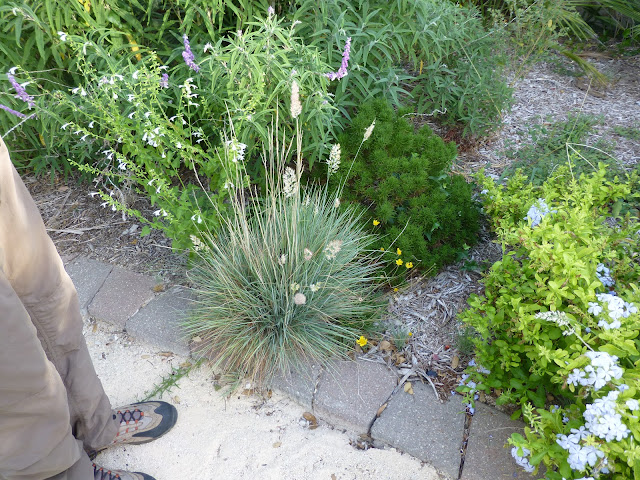The morning was spent at Warbler Woods, a nearby sanctuary in the middle of suburban development. It's always a great stop for birding because Don and Susan Schaezler have created a haven for both resident and migrating birds.
Birding was a bit slow during our time there. But it's always worthwhile when you can sit comfortably and see a Blue-headed Vireo, White-eyed Vireo, Great-crested Flycatcher, and Yellow-breasted Chat, along with other, more common birds mixed in.
Today we spent the morning at the San Antonio Botanical Garden perusing South Texas native plantings. We want to revamp our landscaping at three levels: xeriscaping, wildscaping, mostly native plantings. Here are a few photos of what our front currently looks like during our ongoing drought.
We've already selected a landscaping company, Lafield Landscaping. Terri and Rick are excited about working with us and seem to understand what we want, but willing to go outside our desire to eliminate the lawn completely, and give us a more welcoming front with very limited grass (Zoysia rather than St. Augustine).
I took lots of photos at the Botanical Gardens. I tried to stick with native Texas plants. But some non-natives begged to be included in my photos. I'll provide commentary along the way.
This is Yucca nana, but was unmarked in the gardens. I really like it and would like to see if we can work this into the landscape if it meets enough of our criteria. It's not too large and offers some interesting texture.
This photo is one species of Zoysia, Zoysia japonica. It's a much softer grass than St. Augustine and requires less water. Terie Lafield insists we need some grass to keep our front from being too hard and unwelcoming. After looking at other people's landscapes, Avie and I have come around to understanding she's correct.
Next is an Anacacho Orchid Tree (Bauhinia congesta). Apparently, this is one of the best small ornamental trees for the Central and Southern regions of the state.
Anacacho Orchid Tree is moderately fast growing if given regular watering but is also tough enough to withstand extreme drought. Seems like it fits most of our criteria. Just need to check what it offers wildlife.
This silvery low-growing shrub was unmarked throughout the gardens. But it was quite pretty up against greener landscaping as a border planting.

The landscapers intend to use Purple Trailing Lantana in our garden. I know for a fact it's an incredible butterfly magnet, since we already have some.
However, Lindheimer's Muhly Grass, which can grow over six feet tall, is native to the Edwards Plateau, exactly where we live! It was all over the Botanical Gardens, so we were able to see it in all different kinds of settings.
Butterfly break!!!!! (Gulf Fritillary)
Something I would love to do, and I'm debating it with the landscapers, is yank out the ugly hedges in the front of the house and replace them with a mixed hedge we can allow to grow a bit more organically. Suncatcher (with the yellow flowers) is one of the plants I like for that purpose.
I also love the non-native, but very drought resistant and berry producing Dwarf Barbados Cherry, a plant we already have growing as a natural "weed" in our backyard. It's something I'm hoping we could relocate to the front.
Look how pretty the flowers are close up!
Then there are the Yuccas. They'll add both texture, shelter, and flowers for hummingbirds to the garden. The one we see most often around San Antonio is the Red Yucca, with its pink-red flowers on a high stalk.
The Botanical Gardens also had a Twist-Leaf Yucca, native to the Edward Plateau and indicated for limestone hillsides, exactly where we live.
How about a bush growing chiles (Chili Peqin or Capsicum annuum)? Food for both bird and human!
Avie and I have also discussed a type of native grass called Sideoats Grama. We didn't see any at the Botanical Gardens. But they did have Inland Sea Oats, which they indicated was native to Texas. It had seed heads hanging off each plant. They'd be great food for birds and would be very pretty swaying in a breeze.
Bat-faced Cuphea (Cuphea llavea) is another plant our landscaper wants to put around the gardens. It's a very pretty bush with striking bright red and deep purple flowers which resemble a bat's face.
One final plant is Silver Ponyfoot. We're thinking it might look nice as a full-sun border plant along the driveway. It also hangs over rocks nicely, in case we decide to do something like that with raised beds. This photo isn't from the Gardens, but from a Native Plant Center in New Braunfels.
All in all, the visit to the Gardens made for a great day. We even had a chance to see some birds, such as this juvenile American Robin scratching around the leaf litter for food.


























No comments:
Post a Comment